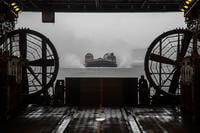
CNN reports that on Thursday, 11 June near Subic Bay in the Philippines, a Chinese Navy (PLAN) submarine hit the sonar towed array of USS John S. McCain, an Arleigh Burke destroyer. McCain, commissioned in 1994, displaces 8,850 tons fully loaded and has provision for an SQR-19B(V)1 passive (listening only) towed array. Neither the ship nor the sub were harmed, but the towed array, a cable fitted with hydrophones, did suffer damage. Unnamed U.S. officials are calling the event an inadvertent encounter, saying they dont think it was a deliberate act of Chinese harrassment.
To me, it sounds more like a close trailing that went bad, something which fits a parsing of the words used by these officials, although there are other plausible explanations that fit equally well. Was the Chinese sub diesel or nuclear powered? This would be important to evaluating deployment ranges and operational abilities of different PLAN sub classes. Were McCains sonarmen aware of the Chinese sub before the collision? This could shed light on the current relative level of Chinese submarine stealth and American surface ship ASW capabilities.
The SQR-19s cable is 1,700 meters (5,600 feet) long, so the sub had to at one point be within one nautical mile of the destroyer. Was the sub intentionally trailing McCain by using the latters propulsion noise as a passive sonar target, but she got too close, and hit the array by accident? (Such an event would be inadvertent, and wouldnt qualify as harrassment because it was unintentional.) Or did the sub approach McCain without realizing she was there, barely miss colliding with her or even sail right under her, and then hit the cable? An Arleigh Burke can be rather quiet if her propulsion noise is being masked by the bulk of her hull. Do Chinese submarine passive sonars have very poor figures of merit?
How did both vessels react right after the event? Did they communicate by radio, perhaps with the submarine surfacing? Or is the only evidence of the Chinese sub a sonar recording and the damaged array?
Given the secrecy of submarine and ASW ops, and the U.S. Navys desire to not sensationalize the late-2006 close encounter beween a Chinese sub and the carrier USS Kitty Hawk near Guam, the public might not hear much more now. But such encounters cant occur unless Chinese submarines and American surface ships are operating in the same waters. The PLAN is certainly beginning to make its undersea presence felt in the strategic First and Second Island Chains separating China from the vast and deep Pacific. Will this trend continue, or even intensify?
-- Joe Buff







